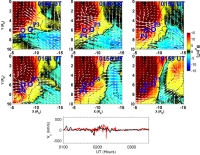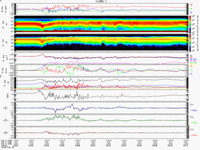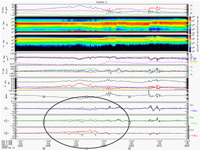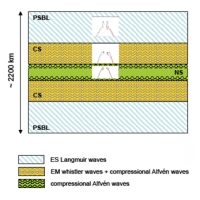Magnetotail and substorms
More than 50 papers were presented on magnetotail dynamics and substorm processes. Various aspects of magnetotail plasma sheet dynamics from global magnetosphere-ionosphere interaction to local microscopic processes in thin current sheets were addressed. This is a detailed summary of this session.
One of the most intriguing questions of substorm physics is when and where a substorm is initiated. The THEMIS mission, employing five identical spacecraft as well as a dense network of ground-based observatories (GBOs), provides a possibility to shed a new light on the matter. Problems of substorm events sequence timing and identification of a substorm onset location in the plasma sheet were the focus of a set of presentations, discussing THEMIS conjunctions. Although the presented data and results are comprehensive and based on multi-point measurements in space and simultaneous ground-based observations, the unique solution of “the substorm problem” is still an open issue. In some cases, the observations suggested magnetic reconnection in the mid-tail plasma sheet as a trigger of substorm activity. However, a substorm initiation by an instability in the near-Earth plasma sheet (at around X=-10 RE) can not be excluded. Complementary experimental evidence, supporting the near-Earth substorm initiation scenario, were also presented. Moreover, it was shown that processes in the near-Earth and mid-tail plasma sheet may act simultaneously. Theoretical models, based on Alfvenic interactions between the stressed magnetotail plasma sheet, dipolar region, and ionosphere, implying fast and shear Alfven waves coupling, support a multi-step scenario of a substorm. It was shown for a series of events, that the time delay between the first indication of activity, detected in-situ by spacecraft, and auroral intensification as observed by the GBO, may be significantly less than the typical Alfvenic interaction time (~ 2 min).
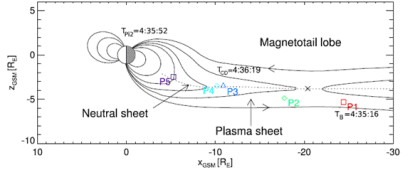 |
|
Figure 1: Location of the THEMIS constellation (P1 to P5) and timing of substorm signatures during the 22 February 2008 major conjunction event. (Courtesy of J. Liu) |
The extended network of 20 ground-based observatories of the THEMIS project allows for a large-scale assessment of the ionospheric signatures of substorms. Each station is equipped with an all-sky camera and a ground magnetometer. The partially overlapping fields of view of the all-sky imagers provide not only a tool for the exact timing of substorm auroral signatures but also for the placement of space-based in-situ measurements into the global context. The dense network of the magnetometers further allows the evaluation of magnetic pulsations (primarily Pc1 and Pi2,) and the extent and development of the ionospheric electrojet. Several presentations addressed the timing of auroral signatures with respect to reconnection and current disruption signatures in space and evaluated the accuracy of magnetic signatures that are not compromised by cloudy skies as the all-sky images.
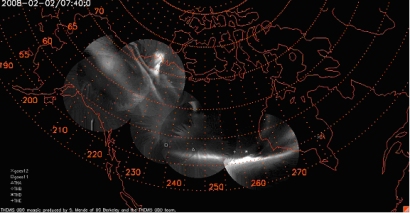 |
|
Figure 2: An example of a THEMIS all-sky camera mosaic. (Courtesy of S. Mende) |
The progress in global MHD and test-particle simulations of substorm dynamics was reported. Global MHD simulations show how meso-scale structures in the MHD simulations and observations fit into the context of the overall tail dynamics. The test-particle simulations, launching both solar wind and ionospheric ions into the electric and magnetic fields from the MHD simulation, showed non-adiabatic motion in the induced electric fields resulting from the reconnection. The simulations well reproduced velocity-dispersed ion structure structures, detected by Cluster (Figure 4), and the burst-like ion acceleration, observed by THEMIS.
To link signatures observed in-situ in the magnetotail and by ground-based optical and magnetic observations, a precise mapping between the magnetosphere and ionosphere is needed. Traditionally, statistical models of the magnetic field, such as the well known T89 or T96 are utilized. It is known, however, that these statistical models may be incorrect during substorms, when the magnetic field is largely distorted. Event-oriented models, based on instantaneous measurements may provide better mapping. Progress and problems in the event-oriented model development were reported. The Global MHD modeling web service, provided by CCMC (Community Coordinated Modeling Center at NASA, GSFC) also includes options to perform mapping between GBOs and the magnetotail.
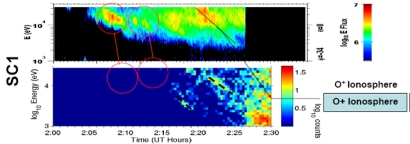 |
|
Figure 4: A comparison between Cluster observations of VDIS (upper panel) and test-particle simulations for the 1 March 2008 event .(Courtesy of M. Ashour-Abdalla et al.). |
A key question of substorm physics is how the magnetic energy, stored in the current sheet, is released and converted to kinetic and thermal energy of particles. For this, the "frozen-in" condition has to be violated in spatially and temporally localized regions. Deviations from the frozen-in condition during fast plasma flows and magnetic field dipolarizations were analyzed utilizing magnetic field, electric field and particle measurements aboard the Cluster and THEMIS spacecraft. It was found that, generally, the frozen-in condition is well satisfied during fast flows and dipolarizations. The major deviations from the frozen-in condition were found at the final stage of growth phases, when a thin current sheet is formed in the near-Earth plasma sheet.
Thinning of the magnetotail plasma sheet during the substorm growth phase results in the appearance of unmagnetized ions, visible in the ion distribution functions collected in the plasma sheet. Examples of such so-called "mushroom-type" distribution functions (Figure 6), observed by THEMIS, and the results of their comparison with a single-peak embedded thin current sheet model were presented. Cluster observations have shown that thin current sheets in the magnetotail are often tilted with respect to the nominal ZGSM direction and may have rather complex current density profiles. It was shown that thin horizontal single-peaked sheets are consistent with predictions of the thin anisotropic current sheet model with multi-component plasmas. For strongly tilted sheets, in accordance with the simple models of slip-type plasma sheet deformation (vertical differential displacement of neighboring flux tubes), the horizontal current density component Jy remains equal to that in the undisturbed horizontal sheet. However, a significantly varying embedded vertical component Jz appears, which is controlled by the local sheet tilt.
Several presentations addressed the physics of microscopic, electron-scale processes in thin current sheets and magnetic field dipolarization regions. The electron current sheet and a series of magnetic islands of the ion-inertial scale were found within reconnection regions using Cluster data. Intense and short lasting (< 4 s) quasi-parallel whistler wave emissions, observed by Cluster at X~-19 RE, were associated with the existence of very thin current sheets (< c/ωpi) as expected in the collisionless Hall reconnection model. The THEMIS equatorial orbit with various probe apogees from 10 RE to 30 RE is complementary to the Cluster polar orbit. THEMIS observations show that quasi-parallel whistler wave emissions are also detected in the near-Earth tail (7-10 RE) around local substorm onset. In the 2007 tail season, Cluster crossed the near-Earth plasma sheet at X~-10 RE with spacecraft separation ranging from 40 to 10000 km, enabling the multi-scale probing of dipolarization regions. The observations showed the presence of the strong inductive electric field and waves, accelerating electrons.
Related Publications
Angelopoulos, A., et al., 2008, "Tail Reconnection Triggering Substorm Onset", Science, Vol. 321, no. 5891, pp. 931 – 935, DOI: 10.1126/science.1160495
Sitnov, M.I., et al.,"Structure and dynamics of a new class of thin current sheets", J. Geophys. Res., Vol. 111, No. A8, A08204, 2006, DOI: 10.1029/2005JA011517

